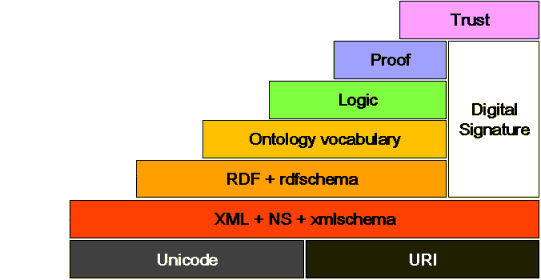Semantic web
<pageby nominor="false" comments="false"/>
Definition
“The Semantic Web is a project that intends to create a universal medium for information exchange by putting documents with computer-processable meaning (semantics) on the World Wide Web.” Wikipedia: Semantic Web
The idea central to the semantic web is that power comes from putting together a variety of islands of knowledge that pre-existed, linking them together.
Technology
People who work on the Semantic Web base their work on the famous "semantic web tower". Its major components are:
The following graph is supposed to capture all the different layers that the semantic web is made of:
The chore technologies are:
- XML, check out the XML entry
- RDF. Semantic web applications are usually built on top of RDF, e.g. see FOAF as a relatively simple example. See also the RDF article, e.g. for information about the "RDF bus".
- Ontologies. Ontologies can be used to capture any knowledge expressed in a semi-structured way. W3C proposed OWL as an ontology standard built on top of RDF
What’s so special about RDF/OWL?
A. To start with, they don’t require a priori fully structured representation of the knowledge like relational database. They are designed to cope with semi-structured types of knowledge.
B. RDF+OWL are designed to live in an open and distributed environment.
C. If you take OWL, for instance, it is grounded into URI (Uniform Resource Identifier). This means that anywhere within your knowledge tree, you put a URI as content of a node. Rather than give a definition of a term or clone the definition form elsewhere like you would be forced to do in a relational database, you can simply refer to some knowledge that is held elsewhere (and eventually kept up to date on that other site). The big distinction then to make is between the URL that corresponds to the usual web page model which can link to a web page like the one of the Guardian (a newspaper in the UK) where the information is susceptible to change everyday and a URI to be used in a knowledge tree. In the second context, the URI doesn’t let you retrieve information content per se but information about where that information content is to be found. An important implication of this is of course that the URI for this second type of resource (pointer to the information content) has to remain persistent for it to be useful to link to it.
D. Ontologies allow for web-like relationships between data, which is not easily done in a typical relational database. This corresponds to a point he made 3 time during the talk. The general idea being that links on the web have some parallel with links in the real world.
Related
The relation to Web 2.0
Web 2.0 does incorporate some "semantics" but globally speaking it is much inspired by making it as simple as possible. E.g. Web 2.0 uses
- Simple RSS (0.91, 2.0) instead of more sophisticated RDF-based RSS 1.0
- Folksonomies instead of formal metadata taxnomies, based on RDF semantics.
- People-driven aggregation of knowledge (e.g. via syndication of the blogsphere) instead of smarter search engines. An exception are some of the best citation indexes that use both approaches.
In other words, Web 2.0 is not very smart, but it brought back people into the network (as planned some 40 years ago by Licklider and Taylor).
There are some interesting initiatives to make the current web smarter without using "heavy" semantic web technology. E.g. microformats, semantic XHTML. Other initiatives, like RDFa try to build a bridge between "pure" RDF and XHTML.
Some examples
- FOAF ("Friends of a friend") is an RDF-based social software for social networks.
- Semantic Media Wiki (At some DSchneider will make a test with this within this wiki)
Discussion
Semantic Web is "heavy". At least today, it requires real programming skills (and that most of the php/javascript/mysql bricoleur community doesn't have, the writer of this sentence included).
Alternatives to the "official" vision of the semantic web are light-weight initiatives using the lowercase semantic web or "real world semantics" metaphor and that can be found in:
- some Web 2.0 applications
- initiatives like microformats and related semantic XHTML (aka "meaningful or lossless XHTML")
Links
- Major Indexes
- Semantic Web. W3C home page. (includes links to all standards, groups, and some publications).
- Dave Beckett's Resource Description Framework (RDF) Resource Guide. This is probably the most complete index of documents.
- ontoworld.org - a "wiki for the Semantic Web community", includes news, events, etc.
- Short Tutorials etc.
- The Semantic Web Made Easy, W3C page, retrieved 16:10, 23 November 2006 (MET).
- FAQs
References
- Hendler, James, Berners-Lee, Tim and Miller, Eric "Integrating Applications on the Semantic Web," Journal of the Institute of Electrical Engineers of Japan, Vol 122(10), October, 2002, p. 676-680. HTML (Reprint).
- Horrocks, Ian; Bijan Parsia, Peter Patel-Schneider and James Hendler (2005). Semantic Web Architecture: Stack or Two Towers, in Francois Fages and Sylvain Soliman, editors, Principles and Practice of Semantic Web Reasoning (PPSWR 2005), number 3703 in LNCS, pages 37-41. SV, 2005. PDF Preprint
- Shadbolt, Nigel; Tim Berners-Lee and Wendy Hall (2006). The Semantic Web Revisited, by , IEEE Intelligent Systems 21(3) pp. 96-101, May/June 2006. PDF.
